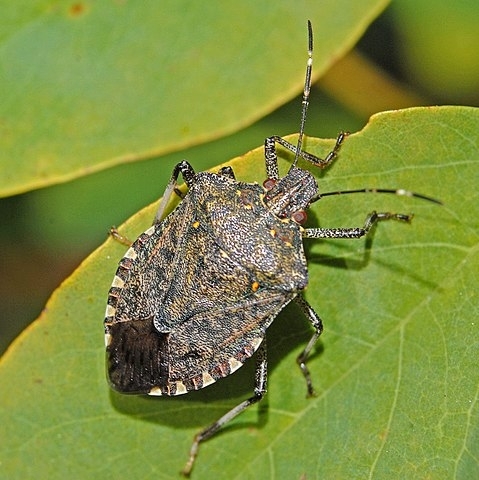Recently brown marmorated stink bugs (Haylomorpha halys) were found in Inyo and Mono counties. This invasive pest from Asia is relatively new to our area. Its first sighting was in Bishop last year.
We have plenty of species of stink bugs on the east side, but this one is especially annoying because it tends to aggregate in large numbers and will attempt to get inside homes and structure to avoid cold weather. As our temperatures return to more normal ranges, I would expect more issues with home ingress.
We have had reports from Swall Meadows down to Big Pine, and possibly an isolated case in Olancha. My hunch is they arrived from northern California, not down south, but there is no way to tell for sure.
As of now, most stink bugs you will encounter are not BMSB. You can identify this pest by a couple notable features: like many stink bugs it is brown, but it has white bands on its antennae and has alternating white and dark coloration on its abdomen. It also has rounded shoulders; similar species in our area have pointed shoulders.
Spraying adult stink bugs doesn't do much good. The best course of action is to ensure your homes are sealed up well so they can't get in.
If these bugs do come inside, they can be trapped easily. (Squishing them is just messy and smelly. Trapping is a better choice.) Here is a video from Virginia Tech showing a good way to trap them.
They can also be vacuumed up. Here is what UC IPM suggests you do:
An efficient way to collect stink bugs indoors is by sucking them up with a dry or wet vacuum. The bugs will cause the collection canister or bag and other parts of the vacuum to give off an unpleasant stink bug odor, so some people dedicate a vacuum cleaner to stink bug capture only. Alternatively, a nylon stocking can be stuffed inside the tube and securing the end over the outside of the vacuum tube with a rubber band; this way, bugs are collected in the stocking and not the vacuum cleaner bag. Individual stink bugs can be brushed off into a cut-off plastic bottle containing an inch of soapy water, where they will drown in a short period of time. If needed, the container can be fastened to a pole or broom handle to reach high locations. Stink bugs caught live also can be placed inside a plastic sealable bag and then into a freezer for 2 days to kill them. To conserve water, avoid flushing them down the toilet and avoid placing live stink bugs in the garbage so they do not become established around landfills.
Hopefully this will just be a minor nuisance for us, and nothing more.
For more information consult this page at UC IPM or send a message to our helpline at immg@ucanr.edu.
This article was originally published in The Backyard Gardener.
